This sign means
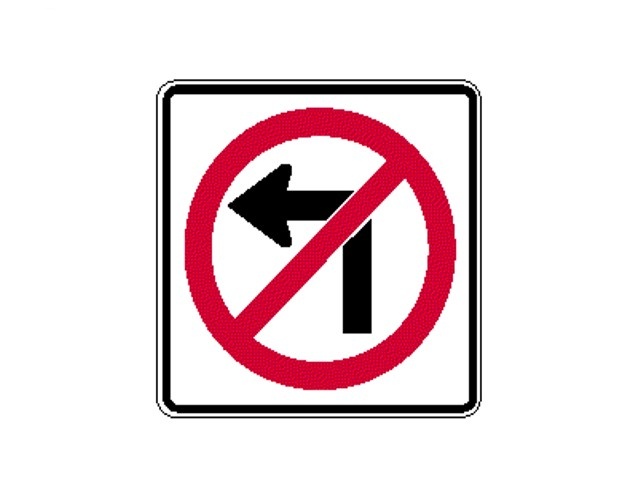
A: no left turns at this intersection
B: the road ends ahead; turn left
C: left turn only at this intersection
D: no left turn from this lane ahead
A: no left turn at this intersection
Which of the following is likely to indicate alcohol impairment?
A: playing very loud music
B: poor speed and distance judgement
C: complaining about the other drivers
D: driving too fast
B: poor speed and distance judgment
A steady red light means
A:stop if traffic is approaching
B: stop, except if turning right
C: stop, then proceed when safe
D:stop before the intersection
D: stop before the intersection
Turn signals should
A: only be used when you are turning corners
B: be used every time you change lanes
C: only be used in heavy traffic
D: be turned on a block ahead of your turn
B: be used every time you change lanes
What action should a driver take when an elderly person has entered a crosswalk?
A: Wave her through.
B: Make eye-contact to let her know he has seen her and wait for her to cross.
C: Tap the horn to ensure that she has seen him and keep going.
D: Keep on going unless she is actually in front of the car.
B: Make eye-contact to let her know he has seen her and wait for her to cross.
This sign means
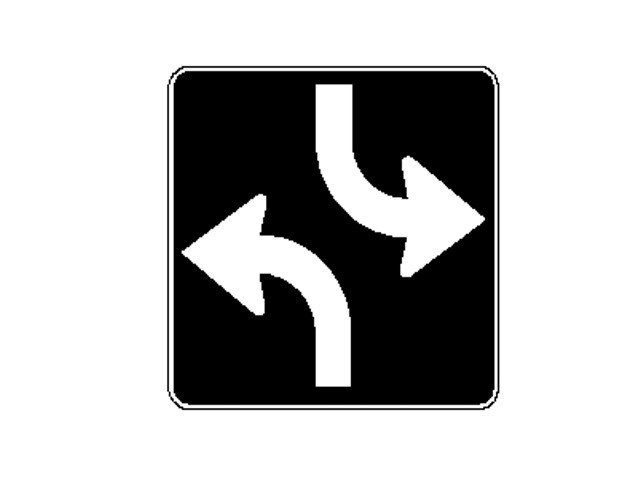
A: two-way left turn lane
B: left turns only at this intersection
C: this lane must turn left or right ahead
D: all traffic must turn left ahead
A: two-way left turn lane
Coating neutral downhill is
A: Safe for experienced drivers
B: hard on the gears
C: a good way to save gas
D: Illegal and unsafe
D: illegal and unsafe
A steady green light means
A: you may drive in this lane
B: you may proceed if the intersection is clear
C: turns are allowed at this intersection
D: slow down and proceed with caution
B: you may proceed if the intersection is clear
Where there are no posted speed limits, maximum speeds are
A: 50 km/h in cities and towns and 80 km/h elsewhere
B: 60 km/h in cities and towns and 90 km/h elsewhere
C: 60 km/h in cities and towns and 80 km/h elsewhere
D: 50 km/h in cities and towns and 90 km/h elsewhere
A: 50 km/h in cities and towns and 80 km/h elsewhere
When poor weather conditions affect how well you can see, you should
A: slow down and turn on your low beam lights
B: maintain your speed but ask your passengers to watch out for hazards
C: turn on your high beam lights
D: drive with hazard lights on
A: slow down and turn on your low beam lights
U-Turns are NOT allowed
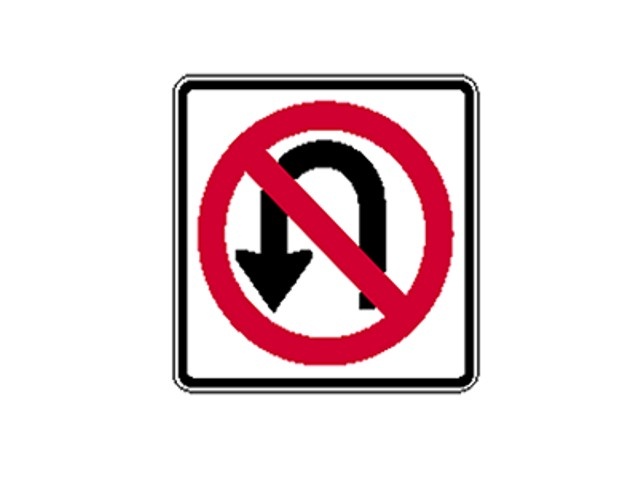
A: In parking lots
B: At intersections with no signs or signals
C: On curves or hilltops
D: In residential areas
C: On curves or hilltops
The best response when your car starts to skid is to
A: Steer away from the direction of the skid
B: Brake and steer in the direction of the skid
C: Ease off the accelerator and steer away from where you want to go
D: Ease off the accelerator and steer where you want to go
D: Ease off the accelerator and steer where you want to go
When a traffic light turns yellow at an intersection, you must
A: stop
B: stop unless it is unsafe
C: reduce your speed
D: proceed with caution
B: stop unless it is unsafe
When a car passes you on a 2-lane road, you should
A: speed up and keep to the right
B: be prepared to slow down and make room
C: maintain your speed and keep to the right
D: always maintain your speed and position in the lane
B: be prepared to slow down and make room
Bridges and overpasses
A: are not generally as slippery as the rest of the road
B: tend to form ice on their surfaces before other road surfaces do
C: are usually not as slippery as they look with snow on them
D: lose their coat of snow first because it melts quickly
B: tend to form ice on their surfaces before other road surfaces do
This sign means
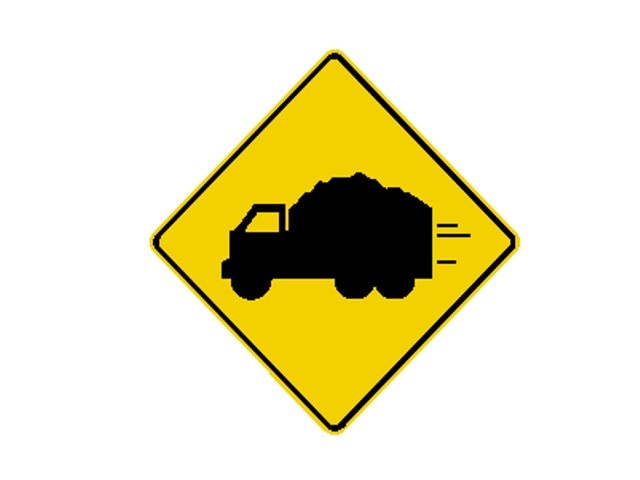
A: trucks are only allowed in passing lanes
B: there is a truck entrance or crossing road
C: drivers should watch for speeding trucks trucks
D: trucks not allowed
B: there is a truck entrance or crossing ahead
In fog, day or night, a driver should reduce speed and use
A: Parking lights
B: Low beam lights
C: Hazard flashers
D: High beam lights
B: High beam lights
When turning left at a green light a driver
A: Must yield to oncoming traffic and wait for a safe gap
B: has the right of way
C: wait until all oncoming traffic is through
D: should turn quickly to clear the intersection
A: must yield to oncoming traffic and wait for a safe gap
An HOV lane can only be used by...
A: bicycles, skateboards and roller blades
B: Trucks, and other large vehicles
C: Buses and carpools and, sometimes bikes and motorcycles
D: Only buses
C: buses carpools, and sometimes bikes and motorcycles
If a driver is entering a traffic circle, he must:
A: maintain speed as he enters the circle
B: yield to any traffic already in the circle
C: signal his direction as he enters.
D: go around the circle clockwise
B: yield to any traffic already in the circle
This signs means
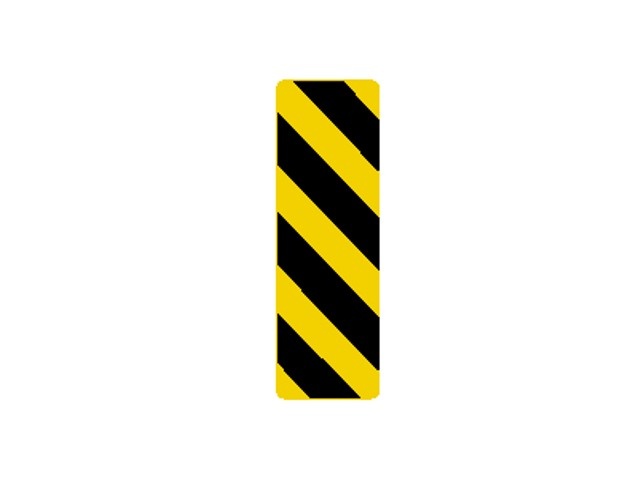
A: one way street; travel only on the right
B: obstruction, keep left
C: the road curves left
D: obstruction, keep right
D: obstruction, keep right
The risk of hydroplaning is higher when
A: snow tires are in use
B: a car is very heavy
C: a car is on a steep slope
D: tires are worn and have little tread
D: tires are worn and have little tread
The light has just turned green. What is the most immediate hazard for the motorcyclist in this picture?
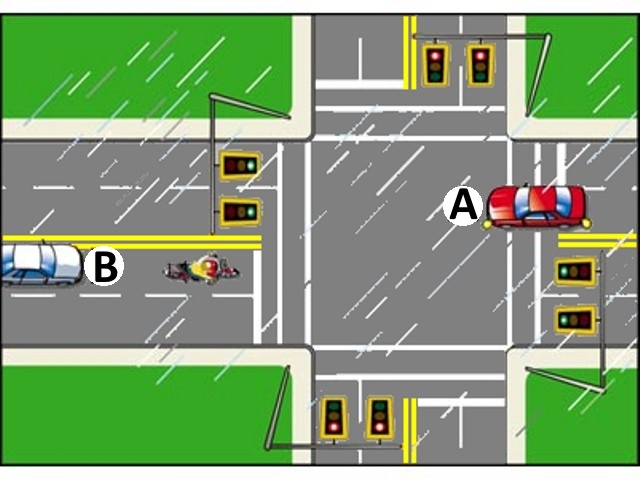
A: The driver of Car A may not see the motorcycle as he turns left and may hit him.
B: Car B behind the motorcycle may run into the back of him.
C: The motorcycle may skid in the rain.
D: Car A may skid in the intersection.
A: The driver of Car A may not see the motorcycle as he turns left and may hit him.
The driver of Car A
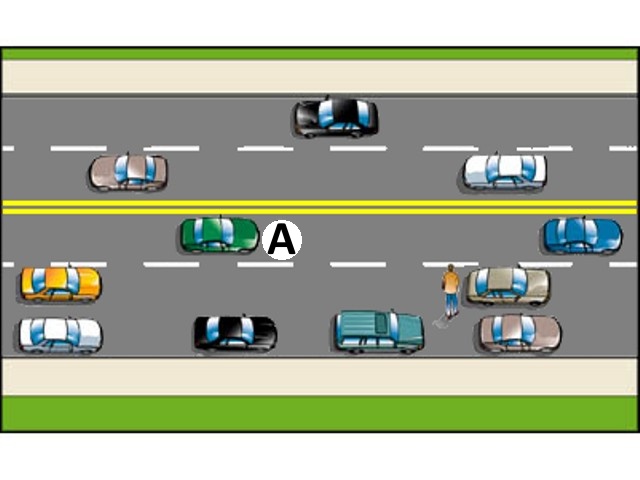
A: must slow down and be prepared to stop
B: must stop and let the person cross
C: must stop and wave the person across
D: should honk and maintain speed
A: must slow down and be prepared to stop
Which of the following is the LEAST safe thing to do when attempting to avoid a collision on a two lane road?
A: Apply the brakes as firmly as you can without locking them.
B: Move into the left lane.
C: Remove your foot from the accelerator.
D: Slow down and keep to the right
B: Move into the left lane.